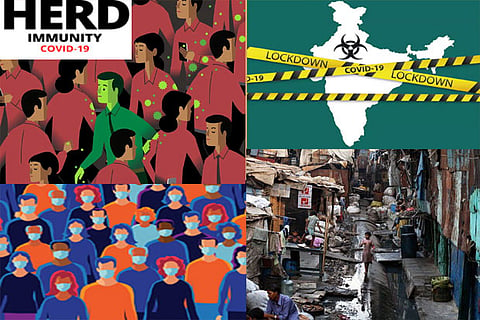

Chennai
The first alternative is the hardest to come by – even as scientists and biologists across the world are racing against time to develop what might be a breakthrough antidote to COVID-19. Over 180 vaccines are currently in various stages of development, of which 26 have hit the human trials phase. Conservative estimates peg an error-free rollout of the first lot of vaccines for the coronavirus to at least a year from now.
This leaves us with the second alternative – i.e. prior infection. It is a dicey proposition owing to its massive human toll. But a development reported a few days ago, might require a reassessment of our approach to tackling the deadly coronavirus. The findings of a serological survey of 6,936 people conducted in July, across slums in three suburbs of Mumbai – namely Dahisar, Chembur, and Matunga, showed that around 6 in 10 people living there have antibodies for the novel coronavirus. The fact that 57 per cent of those surveyed recovered from the infection, is being touted as one of the highest population immunity levels known globally.
The numbers are encouraging when compared to antibody percentages reported in studies of populations of New York City at 21.2% (in April) and Stockholm at 14% (in May). So much so that it even prompted Jayaprakash Muliyil, Chairman, Scientific Advisory Committee of India’s National Institute of Epidemiology to say Mumbai’s slums might have touched herd immunity. But the Centre has distanced itself from any such claims of social immunity.
Last week, when a representative of the Health Ministry was asked if the country was approaching herd immunity, he remarked that in a country with a population the size of India, achieving herd immunity won’t be a strategic choice. “It can only be an outcome with a very high cost.” The cost the officer was referring to was the human cost – of lakhs of people getting infected, getting hospitalised and many in the process, succumbing to the virus.
It might be worth pondering if the actions of those in power are inadvertently leading the population into achieving herd immunity. And that’s because both the Centre and State seemed to have made their peace or rather have accepted what can only be referred to as the collateral damage, that occurs as a fallout of ‘unlocking’ the country. In other words, they aren’t left with any option, but to unlock, and as a result, expose even more populations to the virus.
According to a World Bank report released earlier in July, the economic cost of the pandemic in India is estimated to be around $150 bn in the current year. It added that the lockdowns and closures that the country witnessed in Q1 – Apr-June, had shrunk our economy by a massive 17 per cent. With more than 1.3 bn mouths that need to be fed, a gradual opening up of the economy was only inevitable. And as we have seen in both national and global examples, every subsequent unlocking has resulted in a spike in the infection rates – from the slaughterhouses and car manufacturing plants in Germany to the restaurants in the US and retail districts here in India as well. On Friday last, India saw a record surge of over 55,000 COVID cases being reported nationally, breaching the national tally of 16 lakh cases. And going by the numbers, we might touch the staggering 2 mn mark, much before the second week of August. The best we can do is not let our guard down, and more literally, not let our masks slip.
Visit news.dtnext.in to explore our interactive epaper!
Download the DT Next app for more exciting features!
Click here for iOS
Click here for Android